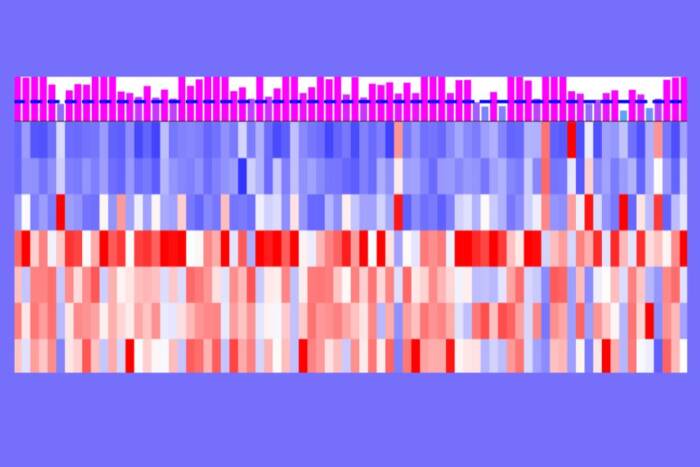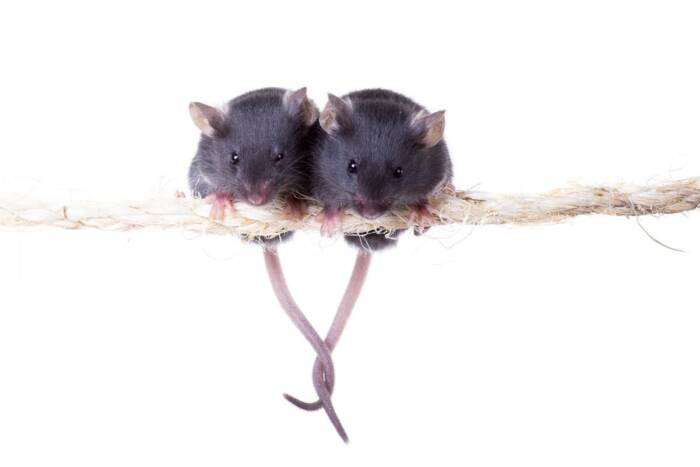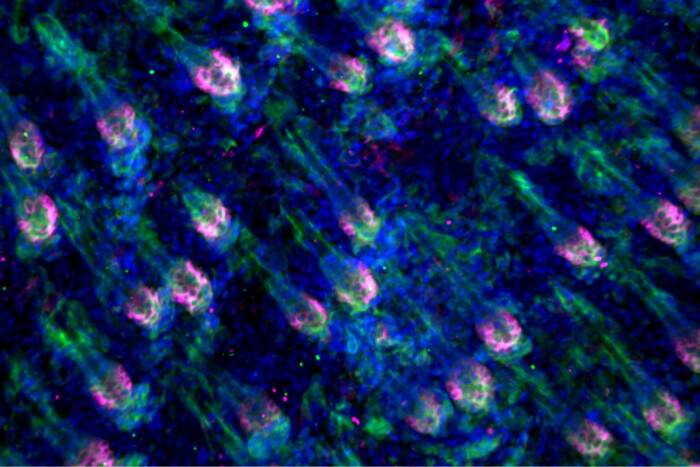"Gene therapy" in worms identifies protein that plays role in controlling water balance, sense of touch in live animals
Using “knockout” mice and mutant roundworms, researchers at The Rockefeller University and the University of California, San Francisco, have identified a protein that helps control water balance in the body and underlies the sensation of touch — functions basic to life that have long eluded explanation.
Both research teams, affiliated with the Howard Hughes Medical Institute, report their findings in back-to-back papers in the October 28 online issue of Proceedings of the National Academy of Sciences. The researchers show that mice and worms born without the protein, an ion channel called TRPV4, have impairments in the regulation of osmotic pressure — the balance of ions from dissolved salts and proteins — and in sensing mechanical stimuli such as touch.
The researchers discovered that when a rat version of the gene that encodes TRPV4 was given to roundworms genetically manipulated to lack a similar gene, the worms regained their lost sense of saltiness and touch.
“The mechanism in cells that controls osmotic pressure has been elusive,” says Jeffrey M. Friedman, M.D., Ph.D., principal investigator of the studies and the Marilyn M. Simpson professor and head of the Laboratory of Molecular Genetics at Rockefeller.
“We now know that the ion channel TRPV4 is one key protein involved in that process, which may be the most precisely regulated parameter in the body,” adds Friedman, who is an investigator at the Howard Hughes Medical Institute. “The protein works by responding to changes in osmotic pressure, and the response to changes in membrane tension produces drastically different responses of the nervous system, depending on the function of the sensory cell that expresses TRPV4.”
“The results of our studies in worms, where we have used a form of ‘gene therapy’ for a genetically impaired worm, suggest that functions of the defective worm protein and the rat protein are conserved by evolution,” says the first author of both studies, Wolfgang Liedtke, M.D., Ph.D., a research assistant professor in the Laboratory of Molecular Genetics at Rockefeller University. “As a result, the rat protein can replace the function of the missing worm protein.”
Ion channels, tiny pores that stud the surfaces of all body cells, allow the passage of ions, atoms that carry electrical charge. Among their many biological functions, ion channels control the pace of the heart, regulate hormone secretion and generate the electrical impulses underlying information transfer in the nervous system. This year’s Nobel Prize in Chemistry was shared by Roderick MacKinnon, M.D., a Rockefeller University professor and HHMI investigator, who was the first scientist to visualize an ion channel (the potassium channel) at the level of its atomic structure.
The TRPV4 ion channel was found to play similar roles in roundworms and mammals, suggesting the protein harbors an ancient, highly conserved biological principle that allows a cell membrane to maintain a certain tension, just like a balloon filled with a certain amount of air or water, say the researchers.
In multicellular organisms, this property forms the basis of sensitivity to touch as well as changes in osmotic pressure, which is sensed by specialized cells, they say.
Friedman and Liedtke had identified the trpv4 gene in 2000 in collaboration with Rockefeller University scientist A. James Hudspeth, also an HHMI investigator, and now say the new findings report a crucial role of the trpv4 gene in living animals. Their earlier findings, reported in the journal Cell, were a result of their search for genes involved in controlling constancy of the internal milieu of mammals, like temperature and osmotic pressure. The Rockefeller researchers focused on a master regulatory region of the brain called the hypothalamus.
The hypothalamus is the place where the actual level of osmotic pressure is sensed and also where counterregulatory measures — drinking and secretion of ADH (anti-diuretic hormone) that tells the kidney to preserve water — are coordinated.
They didn’t find a temperature regulator, but discovered a gene that appeared to be involved in a physiological process at least as fundamental — the regulation of osmotic pressure. Osmotic pressure in mammals, including humans, is maintained with “exquisite precision within the animal,” says Friedman.
TRPV4 had been detected in osmoregulatory cells in the hypothalamus, as well as in cells sensitive to mechanical stimuli such as the trigeminal nerve cells that are sensitive to touch and pain, and the inner ear hair cells that sense sound and change in posture. The type of cells in which TRPV4 had been found led to speculation about the role of TRPV4 in live animals. To determine the protein’s actual function, Liedtke and Friedman designed a set of in vivo experiments.
In the first study, Liedtke and Friedman generated “knockout” mice that lacked the trpv4 gene and thus did not express TRPV4 protein. They found that the engineered mice secreted less anti-diuretic hormone and drank less water compared to normal, or “wild type,” mice. The results suggest that TRPV4 functions as an osmotic sensor in the central nervous system, says Friedman, and that there must be other systems involved in maintaining osmotic pressure, otherwise the engineered mice would not have been able to survive. There are likely “redundant mechanisms at work to maintain normal osmotic pressure,” he says.
The companion study, by the Rockefeller scientists in collaboration with the UCSF researchers Cornelia Bargmann, Ph.D., and David Tobin, Ph.D., studied roundworms (C. elegans) that had a mutation in a gene called osm-9, which encodes another related ion channel. Unlike their wild type cousins, the osm-9 mutant worms do not avoid noxious chemicals, are numb, and have an impaired sensitivity to high osmotic pressure. Worms normally use their sensitivity to osmotic pressure, for example, when they respond to the saltiness of the environment as a clue in navigation.
Curious as to whether OSM-9 and TRPV4 proteins could perform the same function in both simple and complex animals, Liedtke suggested that the mutant roundworms be treated with the mammalian trpv4gene.
“OSM-9 and TRPV4 belong to the same family of ion channel proteins so we decided to throw a rat gene into a worm, and see what happened,” says Liedtke. “To the great excitement of everyone, this rat gene therapy treated the genetic deficiencies in the worms.”
The treated worms withdrew when touched or when encountering a change in osmotic pressure, for example, increased saltiness, yet their lack of withdrawal from noxious smells was unchanged.
But, surprisingly, the two proteins, OSM-9 and TRPV4, are not identical, and in fact, share only about 25 percent of their amino acid sequence. “That you can rescue the function of a mutated gene with another that has only a one-fourth identity is striking,” Liedtke says.
“This shows how a stimulus is translated into language or code that is processable by the nervous system,” says Liedtke. “Here we have one molecule that appears to be involved in the transduction process for mechanical stimuli and osmotic stimuli.”
“This general sensing mechanism seems to be conserved between worms and mammals and that suggests it is a very basic function that must serve the needs of many organisms,” says Friedman.
The research was supported by the National Institutes of Health and the Howard Hughes Medical Institute.
News Releases by this Head of Laboratory
Fat hormone leptin alters brain architecture and activity, which in turn drives feeding behavior(opens in new window)
Jeffrey Friedman, discoverer of leptin, receives Gairdner, Passano awards(opens in new window)


